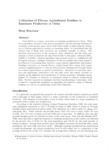Utilization of Fibrous Agricultural Residues in Ruminant Production in China
Tropical agriculture research series : proceedings of a symposium on tropical agriculture researches
| ISSN | 03889386 |
|---|---|
| 書誌レコードID(総合目録DB) | AA00870529 |

本文フルテキスト
tars25-_1-8.pdf1.63 MB
Feed deficit is a major constraint on ruminant production in China. With the tremendous increase in the human population and the growing demand for available cereal grains, great efforts have been made in improving the utilization of fibrous agricultural residues as ruminant feeds. It is estimated that 550 million tons of these feed resources are available annually in China. The nutritive characteristics of the resources, their utilization and the main constraints on their production are described briefly in this paper. Chemical (HN3,NaOH or Ca(OH)2), physical (grinding, high pressure steam or irradiation) and biological (enzyme, ensilage) treatments of fibrous residues have been found to be effective in increasing their nutritive values (mainly digestibility and intake). Feedling ruminants on treated fibrous residue-based diets along with proper nutrient supplementation or with growth-promoter implantation brought about an evident improvement in animal performance. Research on ruminant nutrition and physiology undertaken over the past years has mainly focused on studies on the digestion and metabolism of various nutrients, including energy budget, N, vitamins or minerals of ruminants raised on fibrous residue-based diets. Further research on ruminant nutrition and physiology is necessary, with a need for considerable emphasis on upgrading the nutritive values of fibrous residues, as well as on optimizing rumen fiber digestion.
| 刊行年月日 | |
|---|---|
| 作成者 | Meng Qingxiang |
| 公開者 | Japan International Research Center for Agricultural Sciences |
| 巻 | 25 |
| 開始ページ | 1 |
| 終了ページ | 8 |
| 言語 | eng |
